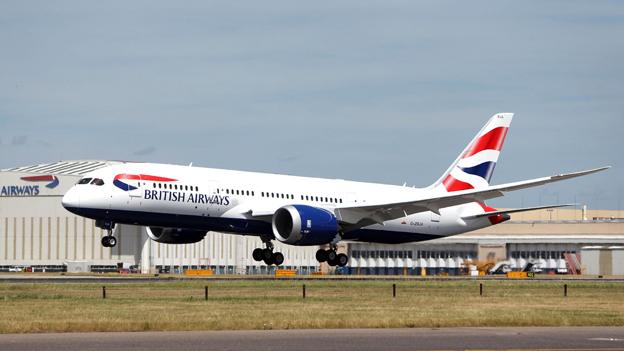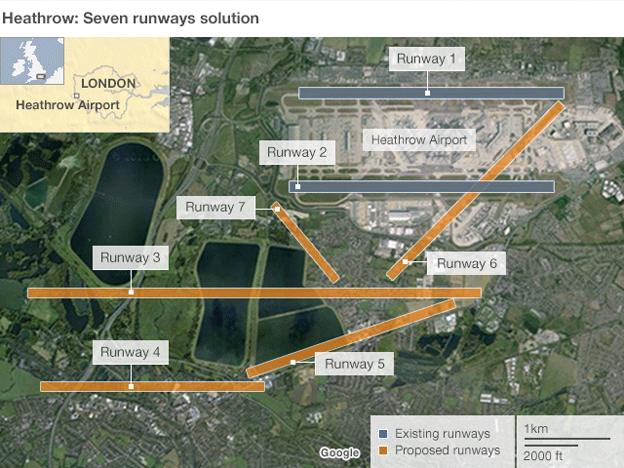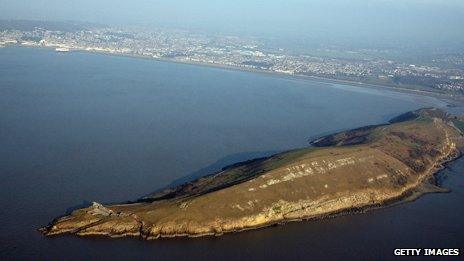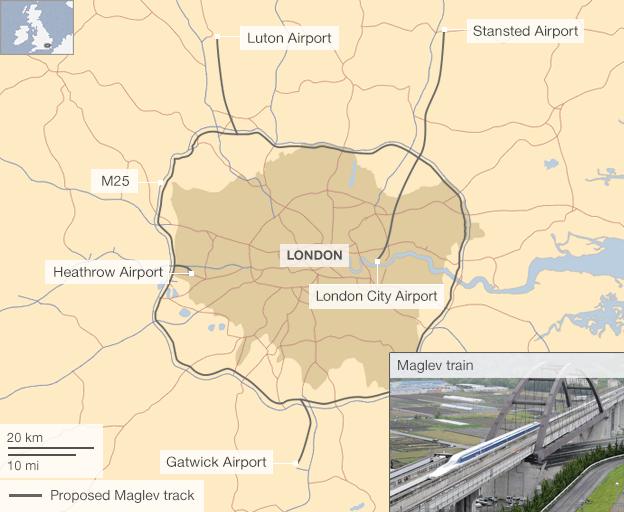Four unusual blue-sky ideas to solve airport capacity
- Published

There's controversy over plans for new runways in south-east England. But how would the public solve the problem of overcrowding at Heathrow and elsewhere?
Various experts have contributed to the debate on whether to build a new runway at Heathrow or at one of the other London airports. Some want an airport further along the Thames or even built in the middle of the estuary.
But here are four ideas submitted by ordinary people to the government's Airports Commission, critiqued by industry experts. The submitters' names have been redacted.
Seven runways at Heathrow
There is a long running struggle over the future of Heathrow and a third runway. One proposal says that is defeatist talk. Try seven.
Amsterdam's Schiphol airport has six, the submission points out. Paris and Frankfurt have four. London's biggest airport only two. "Heathrow needs seven runways to compete directly with Schiphol," the author writes.
The UK's rivals are capitalising on the delays over Heathrow. Our European neighbours are expanding connections to the Bric economies of Brazil, Russia, India and China while Heathrow has run out of capacity. A map displays where the seven runways could fit.

In a handwritten PS, the author urges the government to "grab the bull by the horns otherwise it will be too late".
But experts are sceptical. "You could certainly have three runways at Heathrow," says transport expert Prof David Begg. In the future this can be expanded to four runways if necessary for the main hub.
There is also Gatwick, Stansted, City and Luton which offer business, charter, budget and non-connecting flights. There's no need to close any of these if you open a third Heathrow runway. But seven?
"It's like building an extension to your house when you don't need it," Begg argues.
Severn Estuary Airport

The Severn Estuary could become a plane connection hub in south-west England
Why should most of the airport capacity be in the south-east England? What about those in the west of Britain?
This proposal places a new two-runway international airport on an island in the Severn Estuary. The island can be shaped to help fish pass and work with the estuary's strong tidal pull, the author says. The 12,000 hectare airport will be linked into the M4 motorway and cost about £5bn.
It will help rebalance the national economy. The south-west of England, Midlands and Wales have a population of 13 million people and an aggregated GDP of about £270bn, asserts the author. And yet unlike Greater London they do not have the economic benefit of three major airports on their doorstep. Why should people in the West have to travel to London for most international flights?
Then there's noise. Over time noise restrictions may get stricter. The location, away from major cities, means that Severn24s - the working title - need not worry about future night flight restrictions.
Putting airports in the South East because that's where the demand is creates a self-fulfilling prophecy, the proposal argues. If you allocate the right resources to the regions with long enough runways, then people will use them.
There would be no need to scale back Cardiff or Bristol airports, the proposal contends. Instead the new airport would reinvigorate the West's economy.
Paul Kehoe, chief executive of Birmingham Airport, says the economic case for the Severn airport is "challenging" but not impossible. Heathrow has many strengths. But the UK shouldn't put all its eggs in one south eastern basket.
"There will be 20,000 extra new planes flying by 2030 according to a briefing I've just had from Boeing," Kehoe notes.
Most won't be super-jumbo size but still it's a lot of extra aeroplanes if you accept the Boeing figures. The UK should look outside south-east England to deliver the extra capacity, Kehoe says.
But others argue that what the UK needs is a bigger hub airport where flights can connect. Somewhere like Heathrow.
Aviation consultant Laurie Price says the Severn airport wouldn't work. "Unless you compulsorily close Bristol and Cardiff and direct airlines to the Severn Estuary airport how are you going to deliver it?"
China can tell airlines where to go but that is a command economy, he argues. "We like to think we're a little more democratic."
Maglev train around the M25

Many experts agree that London has enough airport capacity. The problem is it is spread over five airports: Heathrow, Gatwick, City, Luton and Stansted.
What London needs is a bigger hub capable of letting passengers change planes easily. This proposal says it has the answer. Create a high speed Maglev link following the route of the M25.
Maglev trains avoid the friction of wheels by using a magnetic field. Wheel-less journeys are smooth and speeds of over 300mph can be reached. China and Japan have them and other Asian nations are following suit. This proposal says the Maglev could put London's airports within 20 minutes of another rendering the five airports one giant hub.
But experts are unimpressed. "It's a crackpot idea," says Prof Begg. People want to spend a maximum of 40 minutes in an airport transferring from one flight to another. "It doesn't matter how fast the Maglev is, it's not going to be quick enough for people changing planes. You're back to the idea of split hubs again."
Third Heathrow runway, no night flights, and a Universal Hub

This proposal argues that Heathrow should get a third runway. But that it should only allow flights during daylight hours to protect local residents.
Night flights can be moved to other airports with fewer local residents, such as Stansted.
And there will be a universal hub to allow easier transport between London's airports.
The answer is to build a central London rail terminal with fast, dedicated links to each airport, this proposal suggests.
Potential sites for this are Farringdon or Waterloo, the author argues. Fast links would allow passengers to get to Heathrow in 15 minutes and Stansted in 25 minutes.
But Laurie Price is sceptical of both elements of the plan. Banning night flights at Heathrow would cut down by half when long haul flights from Asia or the US could arrive. The jet stream can mean that flights arrive an hour or so early. Would they have to remain in the air for an hour or two over outer London waiting until dawn before they can land?
The universal hub sounds nice. But in practice you can't compete with Schiphol by offering quick train journeys, Price says. At the moment most connecting flights are available at Heathrow. Capacity is running out but this should be replaced at Heathrow with another runway not with fast train services to other airports. "Having to take a train makes it less attractive than a single hub like Amsterdam."
Prof Begg agrees. The magic number is 40, he says. "You have to get people off one plane and on to another in 40 minutes. That is what Schiphol and Dubai do."
You can follow the Magazine on Twitter, external and on Facebook, external